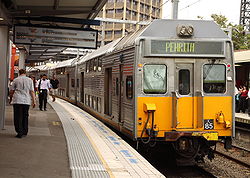- CityRail K set
-
K Set 
K Set 85 at Parramatta railway station
Upper deck of a K set after the Citydecker refurbishmentIn service 1981–present Manufacturer A Goninan & Co. Constructed 1981–1985 Formation 2, 4 and 8 car (two 4 car sets) Capacity 896 seated (8 car set - 106 in driving cars, 118 in trailer cars) Operator RailCorp as the product group CityRail Line(s) served North Shore, Northern, Western and local Newcastle services Specifications Car length 20.385 metres Width 3.036 metres Height 4.368 metres Weight 45 tonnes Traction system 4x Mitsubishi 150 kW Gauge 1,435 mm (4 ft 8 1⁄2 in) The K set is a class of electric multiple unit operated by CityRail in Sydney & Newcastle, New South Wales, Australia. Like the L, R & S sets, the K set is a stainless steel double deck train. The "K" set introduced many new features to the suburban fleet prior to the introduction of the Tangara such as air conditioning and headlights. To accommodate the air conditioning and associated equipment, the pantograph had to be shifted to the adjacent trailer car to which the motor car is semi-permanently coupled and high voltage cables ran between the two cars. The motor cars have four four phase Mitsubishi 150 kW motors (as per R and S Sets), knuckle couplers and a maximum speed of 115 km/h. All carriages were constructed by A Goninan & Co..
Contents
Delivery
The K sets were manufactured in 1981–85:
- 80 Motor Cars - C3501-C3580
- 76 Trailer Cars - T4171-T4246
- 4 Driving Trailer Cars - D4096-D4099
In service
There were two batches to the "K" set fleet, The first batch featured low mounted upper deck windows, brown interiors, and unpainted fronts. The second batch featured higher mounted upper deck windows, SRA "Candy" livery front, and yellow interiors, both of which have disappeared as a result of the "Citydecker" refubishment programme. Prior to the introduction of the Outer-Suburban Tangara "G" sets, some of the "K" sets from the second batch were used on the South Coast and Central Coast line (Via North Shore) peak hour services and these carriages were fitted with high back headrest seats.
Originally, the first four motor cars and driving trailers were the first to be fitted with air conditioning, later two more cars (C3550 and T4216) were also fitted with air conditioning to provide "spare" cars for the "air conditioned suburban train". All remaining "K" set cars were force ventilated until the late 1980s when the second batch (C3551/T4217–C3580/T4246) was fitted with air conditioning, this included the replacement of the "beclawat" windows with sealed non opening windows. The first batch was finally fitted with air conditioning just prior to the Sydney 2000 Olympics. These cars retained the "hopper" windows from its "Citydecker" refurbishment until the late 2000s, but they were sealed shut with an adhesive to avoid the loss of air conditioning.
There are a number of two car "K" sets (K1–K4), which are used on local Newcastle services. These cars return to Hornsby for maintenance, which occurs on a rotational basis. On such occasions, a four car "K" set is substituted on local Newcastle services. In special circumstances, two 2-car "K" sets can be coupled together to form a 4-car set.
Currently all Sydney K-Sets (K60-K99) are maintained at Hornsby maintenance depot and operate on Sector 3, as either four or eight car sets, there are also occasional workings of an eight car set where the other four car set is an "S" set. Six car "K" sets occasionally appear, consisting of either one-and-a-half 4-car K-sets, or a 4-car K-set coupled to a 2-car Newcastle K-set. The trains were originally known as "R" sets. These trains operate the following lines:
- North Shore & Western Lines - Berowra and Emu Plains / Richmond via City
- Northern Line - Hornsby and Epping via / Macquarie Park, City & Strathfield
- Newcastle & Central Coast Line - Around Newcastle area
After the introduction of the new 2009 train time table, most K sets have been allocated to the Northern Line, where they run in 8-car sets. This is due to the noise levels inside trains when operating on the Epping-Chatswood segment of the Northern Line; older R/S-sets do not provide enough sound insulation for passengers, while newer T/G sets do not have sufficient cooling in the regenerative braking system to cope with extended shuttle runs through the tunnel.
External links
Further reading
Beckhaus, John; Halgren, Stephen (2007), Sydney's Electric Trains, Australian Railway Historical Society NSW Division, ISBN 978 0 9757870 8 3
Sydney and New South Wales Rail Rollingstock NSWGR steam locomotive X10 class • Z11 class • Z12 class • Z13 class • Z14 class • Z15 class • Z16 class • Z17 class • Z18 class • Z19 class • Z20 class • Z21 class • Z23 class • Z24 class • Z25 class • Z26 class • Z27 class (2705) • Z28 class • Z29 class • C30 class (3112) • C30T class (3016T) • C32 class (3237) (3265) • C34 class • C35 class (3526) • C36 class (3642) • C38 class (3801) (3820) (3830) • D50 class • D53 class • D55 class • D57 class • D58 class • D59 class (5917) • AD60 classNSW Private Steam SMR10 classDiesel locomotive Electric locomotive Electric multiple unit U set • L, R, and S sets • K set • C set • V set • T & G sets (Tangara) • M set (Millennium) • H set (OSCARs) • A set (Waratah)Diesel railcar Rail transport in New South Wales • Rail rollingstock in New South Wales • CityRail fleet • CountryLink Categories:- CityRail
- Electric multiple units of Australia
Wikimedia Foundation. 2010.


